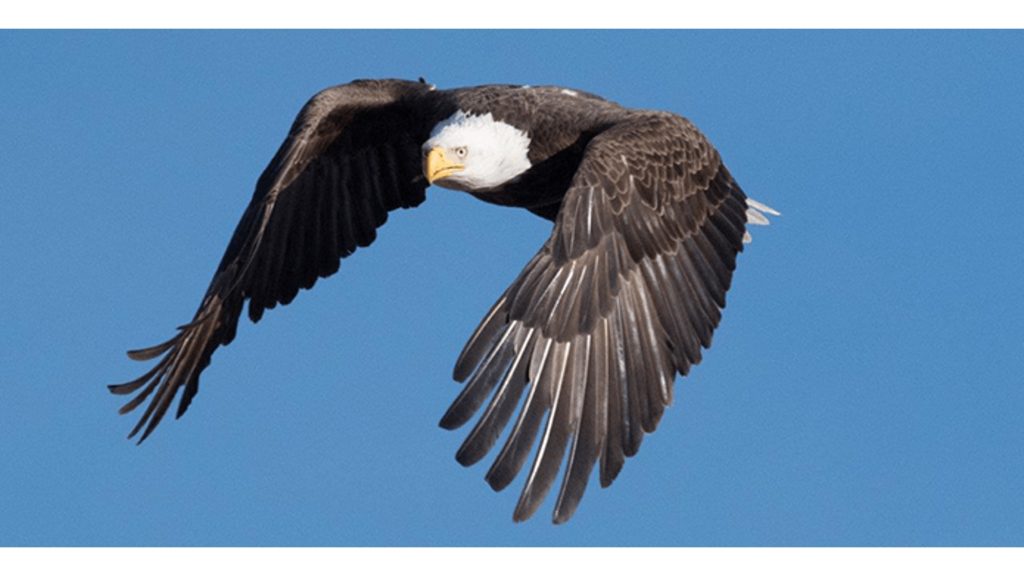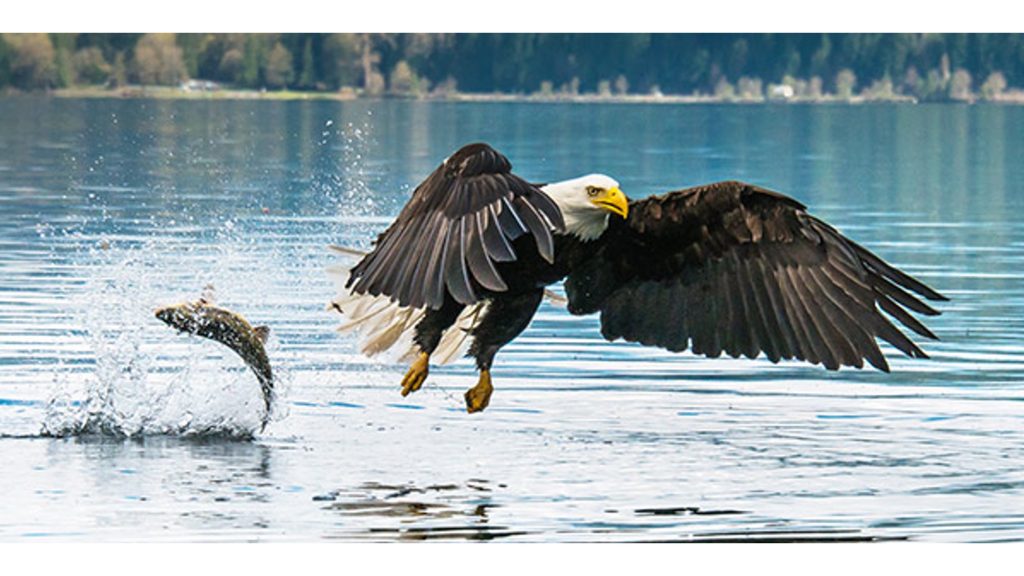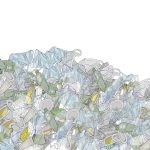Are We Taking Bald Eagles for Granted?
By Raki Krishnan, 2021-2022 Environmental Leader
With sharp yellow beaks, sleek brown coats, white heads, and hard eyes, you can find bald eagles flying around near the Chesapeake Bay. There are estimated to be about 1,400 breeding pairs of bald eagles in the Chesapeake area today (Maryland Birds Conservation Partnership). These majestic birds are much more than just a symbol for America. They are a keystone species, which is a species that is vital to the health of its ecosystem. The bald eagle can fly 20-40 mph in normal flight and can dive at speeds over 100 mph (Seaworld). They are truly a unique gift of nature.
 Photo source: Chesapeake Bay Foundation- Paul Buhrer
Photo source: Chesapeake Bay Foundation- Paul Buhrer
Back in 1782, when the Bald Eagle was adopted as the national symbol, there were over 100,000 nesting pairs of bald eagles living in America. About 200 years later in 1963, there were only around 1,000 nesting pairs living in America (US Fish & Wildlife Service). Now, after the United States government implemented protective laws, the nesting pairs have gone back up to about 10,000, but they are still nowhere near as plentiful as they once were. In fact, many things due to human activity are still threatening these eagles’ lives. Without Bald Eagles, many of the ecosystem services provided to us by local estuary and wetland biomes would not be as fruitful. Bald eagles eat crabs, carp, and other fish in the Chesapeake Bay.

Photo source: National Wildlife Federation
Bald eagles are integral to the health of the ecosystem. If there were a decrease in the bald eagle population, these fish would see an increase in population due to less predators. As a result, the seagrass, algae, eelgrass, and other plants these fish eat would see a large decrease in population due to overgrazing. These marine plants play the essential role of helping to filter the Bay water. Without them, toxic metals and high-nutrient fertilizers can end up getting into the habitat and cause eutrophication. When eutrophication occurs, the entire ecosystem can become uninhabitable to virtually all species, and all of the ecosystem services that were provided to humans will no longer be available. All of the fishing and tourism industries that are drawn by the Chesapeake will be hit heavily. Local businesses that depend on the Chesapeake Bay’s health in order to flourish will start to lose business. Recreational activities would no longer be able to be hosted at the Chesapeake Bay. Many of the ten million people that live near the shores of the Chesapeake bay will be impacted.
The Endangered Species Act of 1973 has provided a framework for us to prevent endangered species from going extinct, and it is part of the reason Bald Eagles are doing better (US Fish & Wildlife Service). However, today, species are vanishing 1,000 times faster than the time before humans existed (Dell’Amore).
Mercury is a toxic byproduct of coal-fired power plants. It is a neurotoxin that can have harmful and possibly fatal effects on the nervous system, immune system, and digestive system. Two thirds of the mercury that is circulating in the environment is due to human activities, and 40% of the mercury pollution is because of coal-fired power plants (CBF). By burning fossil fuels, we are enabling mercury levels in aquatic ecosystems to rise. As a result, the fish absorb the mercury through their food and their gills. The mercury in their system is then tightly bound to the proteins. This is a part of the reason that the bald eagle population is not growing back as strong as it could. Since bald eagles eat fish, they also end up eating the mercury that was part of the fish. This can affect the health of the bald eagles and the health of their eggs/babies. The easiest way to solve this problem is by stopping the usage of coal-fired power plants and transferring to other means of creating energy, so that mercury poisoning does not become even more of a problem in the future. Below is an image of water that is contaminated by mercury.
 Photo source: The conversation
Photo source: The conversation
So, what can you do to help?
- Educate! Educating people around you about mercury and its effects on bald eagles can make all the difference. Once people are aware of what is happening, they too can spread the knowledge as well as making other efforts to help.
- Reduce! Reducing the amount of products we consume altogether can help, especially reducing the purchase of products that were manufactured using a coal-fired plant is even better.
- Recycle! The waste incinerators sometimes release mercury, so decreasing their need to function will help decrease the amount of mercury in the ecosystem.
- Vote! Vote for the officers on local, state, and national levels. Make sure to vote for the ones that prioritize reducing pollution and conserving ecosystems. Although we can do a lot on an individual level, the US government’s cooperation is needed to reach the greatest impact of conservation efforts.
- Convert! Change your house, car, and other devices to run on renewable energy instead of fossil fuels. If this is too expensive for you, then natural gas is a better option than coal because it produces less toxins.
- Donate! There are many nonprofit organizations that are making efforts to clean up polluted ecosystems. Volunteer to get out and work with them or donate money to help their operation.
Works Cited
Mercury. (2020). Chesapeake Bay Foundation. https://www.cbf.org/issues/chemical-contamination/mercury.html
Bald Eagle. (2020). Chesapeake Bay Program. https://www.chesapeakebay.net/S=0/fieldguide/critter/bald_eagle
Bald Eagle Facts and Information. (2021). SeaWorld Parks & Entertainment. https://seaworld.org/animals/facts/birds/bald-eagle/
Bald Eagle Nest Monitoring. (2021). Maryland Bird Conservation Partnership. https://marylandbirds.org/bald-eagle-nest-monitoring
Bald Eagles. (2020). Chesapeake Bay Program. https://www.chesapeakebay.net/state/bald_eagles
Buhrer, P. (2019, February 29). Photo of the Week: Eagle in Flight. Chesapeake Bay Foundation. https://www.cbf.org/blogs/save-the-bay/2019/02/photo-of-the-week-eagle-in-flight.html
Center for Conservation Biology. https://ccbbirds.org/2010/07/12/mercury-levels-in-chesapeake-bay-bald-eagles/
Dell’Amore, C. (2021, May 3). Species Extinction Happening 1,000 Times Faster Because of Humans? National Geographic. https://www.nationalgeographic.com/adventure/article/140529-conservation-science-animals-species-endangered-extinction
Gerson, J., Wadle, A., & Parham, J. (2020, May 28). Gold rush, mercury legacy: Small-scale mining for gold has produced long-lasting toxic pollution, from 1860s California to modern Peru. The Conversation. https://theconversation.com/gold-rush-mercury-legacy-small-scale-mining-for-gold-has-produced-long-lasting-toxic-pollution-from-1860s-california-to-modern-peru-133324
Mercury. (2020). Chesapeake Bay Foundation. https://www.cbf.org/issues/chemical-contamination/mercury.html
Mercury in U.S. Coal — Abundance, Distribution, and Modes of Occurrence. (2001, September). U.S. Department of the Interior U.S. Geological Survey. https://pubs.usgs.gov/fs/fs095-01/fs095-01.html
Mercury widespread in Chesapeake Bay headwaters fish. (2020, July 2). United States Geological Survey. https://www.usgs.gov/center-news/mercury-widespread-chesapeake-bay-headwaters-fish#:%7E:text=The%20Chesapeake%20watershed%27s%20mercury%20levels,the%20country%2C%20the%20authors%20say.
U.S. Fish and Wildlife Service. (2019, July). Fact Sheet Natural History, Ecology and Recovery. U.S. Fish & Wildlife Service. https://www.fws.gov/midwest/eagle/Nhistory/biologue.html
U.S. Fish and Wildlife Service. (2020, May 5). Federal Laws that Protect Bald and Golden Eagles. https://www.fws.gov/midwest/eagle/history/protections.html
About the Author:
 Raki Krishnan, 2021-2022 Environmental Leader
Raki Krishnan, 2021-2022 Environmental Leader
Raki is a Senior at Walt Whitman High School. He has been passionate about creating a sustainable future since he was young. Recently, he has started to take action on this passion. Working with other people to make a positive difference in the community is something that he believes can go a long way. He hopes to learn a lot more about sustainability and implementation of community projects through the Environmental Leaders Program.





